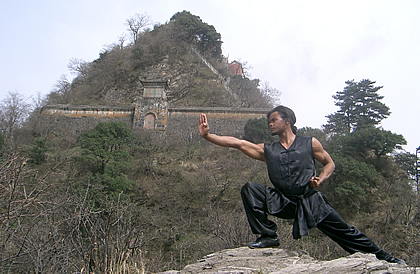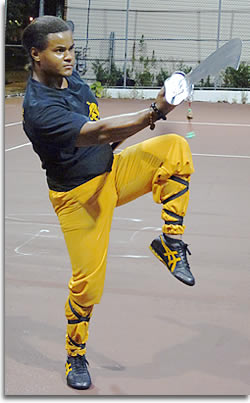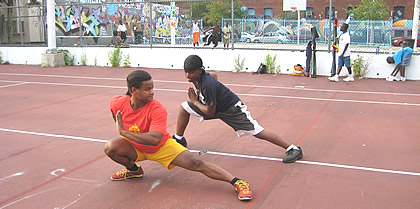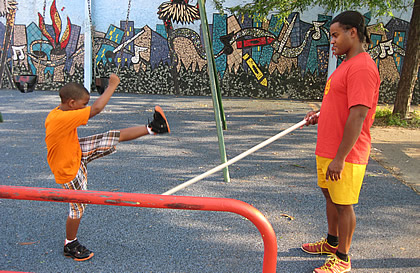
Shaolin Basic Skills (Exercises)
That wasn't their only surprise. Although he stood 5'7", Rucker may have been the most muscular student the school ever had, looking more like a competitive body builder than a wushu artist.
As to fitness, Rucker had earned his BS degree in Exercise Physiology and he worked fulltime as a fitness trainer in a medical clinic. He was in top form.
Regarding his training, Rucker studied 10 years with Zhang Xichuan in the fundamentals of traditional wushu, including the five stances, piquaquan (literally "chop-hanging fist"), fanziquan (translated various ways, including "tumbling fists"), Chinese Military Police Boxing, Shaolin Short Stick and Elementary Shaolin Animals.
 |
His commitment was clear. Rucker left his job, moved out of his apartment and sold his cars, to study in China. And he went with a specific goal in mind.
Rucker's decision to study at one of China's leading wushu academies was more than a desire to continue his martial arts education. He had a plan. "From my training in wushu and my education at the University, I knew the value of a systematic approach to training, and I wanted to learn the methods that produced a top-level Chinese wushu athlete… I wanted to know what they learned as children, as adolescents and as adults. I needed to expand my knowledge as well as myself."
Rucker's father introduced him to a variety of sports including basketball, football and baseball, but it was his mother's love of art that gave him the ability to view the world from an alternative perspective. The journey began when Rucker was 17. He was a regular at the YMCA in Fort Washington, Pennsylvania, which offered a variety of fitness activities. Zhang Xichuan, who had emigrated from Xi'an, China in 1994, was one of the instructors. Rucker noticed him "practicing these strange dances in front of a mirror" in between classes. The "dances" were traditional Chinese wushu routines and they intrigued young Rucker.
Master Zhang, who had earned a master's degree in martial arts from the Xi'an Physical Education College, was also trained in martial arts while in the Chinese military. He later became a Grandmaster of Zhang style tai chi gong. Rucker became his first serious student to embrace traditional wushu and remained a devoted student for 10 years.
Master Zhang provided Rucker with a solid background in the basics. "Often we practiced in the park, just Master Zhang and me. I learned fundamental stances and postures as well as elementary 5-stance boxing, piquaquan (a Northern style which few Americans had learned at that time), fanziquan, Shaolin short stick, elementary five animal boxing, and the same Chinese Military Police Boxing Master Zhang had learned. Master Zhang was fresh out of the military, and he had me frog-jumping and kicking the length of a football field."
While Rucker continued his wushu training, he also earned a BS degree in exercise physiology from West Chester University. After working as fitness trainer for a year, he then accepted a fulltime position as an exercise physiologist with the Girard Medical Center in Philadelphia. Despite his scientific education and his wushu training, he yearned for a deeper understanding of wushu. He wanted more than just to expand his repertoire of wushu forms and improve his technique. He wanted to experience and understand how serious martial artists learned their art in China. To do that he felt he had go to the source.
 |
He knew that Master Zhang had briefly studied with Zhao Changjun, China's All-Around Wushu Champion from 1978 to 1987. Zhao's record of consecutive championships surpassed the record set by Jet Li in the 1970s. In 1991, Zhao opened a large martial arts boarding school in his native Xi'an for students of all ages. It has since graduated over 10,000 students, several of whom have gone on to become champions, coaches and teachers.
As one of only 3 foreigners in the school of about 700 students, Rucker knew that he would likely confront the image of Americans as unwilling or unable to handle the harshness of fulltime training. "They wanted to see if I could eat bitter (chi ku 吃的苦)." The schedule was intense - three hours in the morning and 4 hours in the afternoon - leaving students completely drained at the end of the day. The school's culture was such that "you went all out on every move of every routine," said Rucker. "Those students who gave their all were held in the highest regard, even if it meant they collapsed during a workout."
His early training in Philadelphia, with its focus on the fundamentals, had prepared him well. He also had the fitness and strength to keep pace. Rucker also recognized the importance of being humble in Asian culture. There was no bragging or displays of bravado at the school as is common among American athletes. "Even when I knew I could be first in a sprint or an exercise we were practicing, I made sure that I was second or third so not to show up the other students." He was also keenly aware that he was the first American that many of these people had seen in person and possibly the only African-American they would meet. "I knew I represented an entire population back in America, and their impression of me would probably stay with them for a lifetime. It meant I could never give up or act inappropriately."
He also used his background in the science of fitness to contribute to the school. "They knew little about weight training. They had some equipment, but it went unused. I cleaned up a room and refurbished their equipment. After many of the other students saw me lift, they asked me to teach them how to train with weights."
He spent his evenings studying Mandarin. "Even though I had a few courses in Chinese before I went to China, it wasn't until 3 months into my stay that I began to understand what people were saying."
The school had a faculty of about 15 teachers. Rucker's "everyday teacher" was Ma Yuan, nephew of Zhao Changjun and a national champion. In addition, Ma Bo, another national champion and grandson of wushu legend Ma Zhenbang, taught him bajiquan and xingyi. Rucker also studied Northern 5 Animal Boxing with Liu Guan Fan. As a special honor, Master Zhao invited Rucker to weekly workouts that he conducted with the faculty. Master Zhao also taught him chaquan, shi lu tan tui, pigua, dao shu (broadsword) and supervised Rucker's overall training. But the highest tribute he received was when the faculty asked him to reach deeper. "When the teacher singled me out to do an extra 10 butterfly kicks after our class had just done 10, I knew that I had made it." In America, that might have been considered a punishment, but in China it was a sign that the teacher felt him capable of an additional challenge.
 |
The school often brought in visiting teachers for seminars on new forms such as regional styles. Rucker wanted to absorb all he could from these sessions, so he developed a system for memorizing new routines. "I took an elective in mental training in college and learned that the brain generally retains eight things—digits, functions, etc.-before it needs to review. The number 8, which is lucky in Chinese culture, appears several times in taiji and wushu - 64 hexagrams of the i ching, ba gua philosophy, and bajiquan. Many taiji forms are divisible by 8." Rucker found that if he reviewed each group of 8 movements 8 times, either by visualizing them or actually performing them, he could learn a full form in 1 to 2 hours. "I found that if I practiced the form at least 8 times for 9 days, it would be firmly imprinted upon the brain. This meant I could devote the rest of my practices to focusing on speed, timing, accuracy, power, breathing, and spirit."
After 10 months, Rucker had come to understand the philosophy of how wushu should be taught and the relationships between forms. "I believe wushu is a series of 'gate styles,' that once you achieve proficiency, a gate will open to other external forms. The key is to choose the right ones for yourself or, if you are lucky, a teacher will choose for you. Tan tui, changquan (long fists 長拳), ji ben gong (fundamental training 通過本功 ) open the door to learning other external northern styles: 5 animal fists, lohanquan, hongquan, lianhuanquan (continuous linking fists 羅漢拳, 洪拳, 五聯拳). This, in turn, opens the gate to many Shaolin forms."
Rucker wanted to eventually teach traditional wushu, but he had strong feelings about what a teacher needed to know before they could instruct a student. "No discredit to the teachers in the US, but to be a good teacher, you need to know how to communicate more than just 'practice, practice.' You need to know the whole story in order to lead students to the next level. This includes learning Chinese and English. For example, Chinese wushu uses imagery to describe moves. Wu long pan da means something specific in Chinese; it has been translated as twisting fists in English, which doesn't fully describe the move-black dragon twining, writhing hit. Teachers need to understand the forms to communicate the subtleties to students." Rucker feels teachers should help students structure their training. "Students often wonder how to train; do they spend 2 hours on iron fist by hitting a tree, or practice their forms or focus on hitting the heavy bag? Too many teachers string students along. A great teacher can provide clarity and sound methods on how individual students can structure their training and reach a higher level."
 |
When he returned to Philadelphia, he was fortunate that his former employer readily took him back. Rucker also felt he was ready to pass on what he had learned. "I didn't aspire to be the best martial artist, but I wanted to be a great teacher, and to teach the sound training methods." His old teacher Zhang had left his teaching at the YMCA and the Hawthorne Cultural Center in Philadelphia to open his own school in 2006. This left an opening that Rucker used to start his own program teaching taiji and wushu classes. But Rucker wanted to bring what he had learned to the inner city.
In 2005, began teaching wushu gong fu at the Hawthorne Cultural Center in South Philadelphia. It probably stands as one of the few programs in traditional Chinese wushu located in an American inner city. Rucker feels "no one should be prevented from studying wushu because they can't afford it. I never turn away a student because of financial difficulties. I know I'm fulfilling one of my goals in the wushu world.
 |
"Every culture has martial arts, but in China it became more than a military function. Wushu also became a means to cultivate the mind and structure for the living a fulfilling life."
As a postscript to Rucker's journey, Master Zhao Changjun opened a school in Moorestown, NJ not far from Hasan Rucker's school in Philadelphia where he teaches, although he continues to operate his school in Xi'an. When Master Zhao held a wushu tournament in Moorestown, NJ in May 2010, many of Rucker's students participated.




0 comments:
Post a Comment